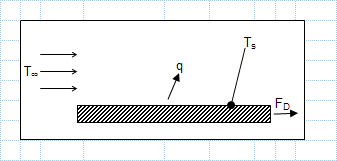Drag force in air flow.xls

Description
KNOWN: Air flow conditions and drag force associated with a heater of prescribed surface temperature and area
FIND: Required heater power.
ASSUMPTIONS: 1) Steady state conditions.
2) Reynolds analogy is applicable.
3) Bottom surface is adiabatic.
Calculation Reference
Fundamentals of Heat and Mass Transfer - Frank P. Incropera
To find the required heater power in an air flow, considering the air flow conditions and drag force associated with a heater of prescribed surface temperature and area, you can follow these steps:
-
Calculate the drag coefficient: The drag coefficient (Cd) represents the resistance to the flow of air around the heater. It can be obtained through experimental measurements or by using known correlations for specific shapes or geometries.
-
Calculate the dynamic pressure: The dynamic pressure (q) of the air flow can be calculated using the formula:
q = 0.5 * ρ * V^2
Where ρ is the air density and V is the velocity of the air flow.
-
Calculate the drag force: The drag force (Fd) exerted on the heater can be calculated using the equation:
Fd = Cd * q * A
Where A is the area of the heater exposed to the air flow.
-
Apply Reynolds analogy: The Reynolds analogy states that the drag force and the heat transfer rate are proportional to each other. Therefore, you can assume that the required heater power (P) is directly proportional to the drag force:
P = Fd * k
Where k is a proportionality constant that relates the drag force to the required heater power. The value of k depends on the specific system and the properties of the heater.
-
Solve for the required heater power: Substitute the value of the drag force into the equation from step 4 and solve for the required heater power (P).
By following these steps and utilizing the Reynolds analogy, you can find the required heater power in an air flow based on the air flow conditions and the drag force associated with the heater of prescribed surface temperature and area. The assumption of steady-state conditions and the assumption that the bottom surface is adiabatic allows for simplified analysis.
Calculation Preview
Full download access to any calculation is available to users with a paid or awarded subscription (XLC Pro).
Subscriptions are free to contributors to the site, alternatively they can be purchased.
Click here for information on subscriptions.
